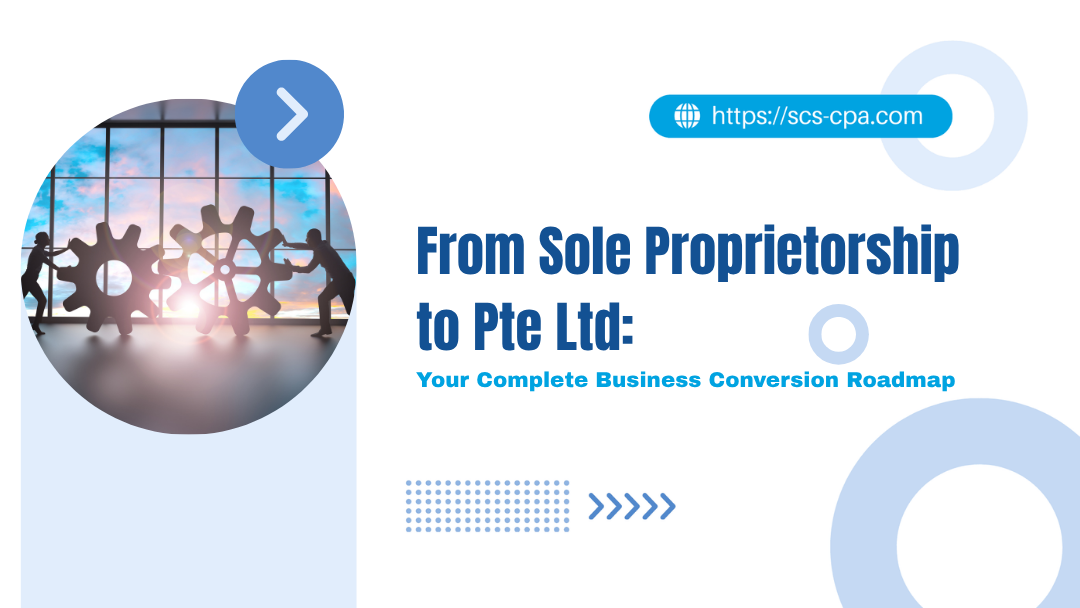
Transitioning from a sole proprietorship to a private limited company (Pte Ltd) signifies growth and professionalism. This structure enhances credibility, limits personal liability, and attracts investors. Hence, careful planning and understanding of regulations are essential.
This guide will help you through the whole process. It covers the differences between the two structures and how to make the conversion smooth.
Key Overview: Sole Proprietorship vs Private Limited Company (Pte Ltd)

Structure and Liability
A sole proprietorship is owned by one individual who is personally responsible for all debts and obligations.
A private limited company (Pte Ltd) is a separate legal entity. The company, not the owner, bears the risk. Shareholders’ personal assets are protected, and liability is limited to their share capital.
|
Aspect |
Sole Proprietorship |
Pte Ltd (Private Limited) |
|
Legal Entity |
The owner and the business are one |
Separate legal entity |
|
Liability |
Unlimited |
Limited to share capital |
|
Ownership |
Sole owner |
One or more shareholders |
|
Funding |
Limited personal funds |
Can issue shares to investors |
|
Public Perception |
Suitable for small setups |
Higher credibility with clients and banks |
More reading: Which Business Structure Should I Choose for a Startup in Singapore? (2025)
Taxation
Sole proprietors pay personal income tax, which can be as high as 24%.
Pte Ltd companies pay a corporate tax rate of 17% with possible exemptions:
- 75% exemption on the first S$100,000 of chargeable income for the first 3 years
- 50% exemption on the next S$100,000
This makes incorporation highly tax-efficient for growing businesses.
Compliance Requirements
Pte Ltd companies must:
- Appoint at least one local director and a qualified company secretary
- File annual returns and hold Annual General Meetings (AGMs)
- Maintain separate accounting and corporate tax filings
Sole proprietorships have simpler compliance, requiring only annual renewal with ACRA and filing of taxes as personal income.
Succession and Continuity
A sole proprietorship ends when the owner retires or passes away.
A Pte Ltd continues as a separate legal entity, ensuring business continuity and succession planning.
Critical Questions to Consider Before Converting

- Is your business growing in size or revenue?
If yes, a Pte Ltd structure offers scalability and credibility. - Do you need intellectual property protection or external investors?
Pte Ltd companies can own IP assets and raise equity capital. - Do you want to reduce personal legal risk?
A Pte Ltd shields personal assets from business liabilities. - What are your future goals?
For regional expansion or partnerships, incorporation is essential.
Before and After Conversion Snapshot
|
Category |
Before (Sole Proprietorship) |
After (Pte Ltd) |
|
Tax Filing |
Personal income tax |
Corporate income tax |
|
Liability |
Unlimited |
Limited |
|
Business Ownership |
Sole ownership |
Shareholders |
|
Compliance |
Minimal |
Regular statutory filings |
|
Financing |
Personal savings |
Equity or venture funding |
How to Change From Sole Proprietorship to Pte Ltd: Step-by-Step Guide

Step 1: Obtain Approvals and a No-Objection Letter
If you wish to retain your existing business name, obtain a No-Objection Letter from yourself (as the sole proprietor) or all partners. Doing so allows the name to be reused for the new Pte Ltd.
Step 2: Register Your New Company with ACRA
Apply on ACRA BizFile+:
- Reserve your company name
- Prepare incorporation documents (Constitution, director and shareholder details, registered address)
- Pay the registration fee
Upon approval, ACRA issues a Certificate of Incorporation and a Unique Entity Number (UEN).
Step 3: Transfer Business Assets
Move all operational assets under the new company. This includes:
- Bank accounts and merchant services
- Contracts, leases, and supplier agreements
- Business licenses and permits
- Intellectual property and branding
Document each transfer clearly to maintain legal continuity.
Step 4: Close the Sole Proprietorship
Once all transfers are completed, cancel your old business via BizFile+.
According to ACRA, this must be done within three months of incorporation to avoid duplicate records.
Common Mistakes to Avoid
- Delaying the closure of the sole proprietorship after incorporation
- Not transferring licenses or contracts, leading to invalid agreements
- Failing to update clients, suppliers, and regulators about the new company
- Ignoring tax changes since Pte Ltd companies file corporate, not personal, taxes
- Not maintaining separate bank accounts or accounting records
- Skipping compliance setup, such as appointing a company secretary or auditor
💡 Pro Tip: Create a conversion checklist before you begin to prevent missing steps during the transfer.
Post-Conversion Essentials

Compliance Requirements
After incorporation, ensure you:
- Appoint a company secretary within six months
- Hold Annual General Meetings (AGM)
- Register for CPF and Skills Development Levy (SDL) for employees
- Apply for GST registration if annual revenue exceeds S$1 million
- Re-register relevant business licenses
Notifications
Inform:
- IRAS for tax updates
- Banks to update accounts
- Suppliers and clients to reissue contracts
- Government agencies regarding transferred licenses
Accounting and Record Keeping
Implement professional accounting software, maintain digital records, and conduct periodic financial reviews to comply with Singapore Financial Reporting Standards (SFRS).
💡 Pro Tip: You can use this article, Annual Compliance Requirement for Pte Ltd Companies in Singapore, as your guide to stay compliant.
Weighing the Pros and Cons
|
Advantages of Conversion |
Challenges to Expect |
|
Limited liability for owners |
Increased compliance cost |
|
Greater tax efficiency |
More administrative duties |
|
Easier access to funding |
Must appoint officers and hold AGMs |
|
Stronger business credibility |
Requires detailed accounting |
Overall, the benefits of forming a Pte Ltd far outweigh the added complexity, especially for businesses aiming to grow sustainably.
How Corporate Service Providers Can Help

Partnering with a professional corporate service provider (CSP), like Singapore Corporate Services, can simplify your transition. They can:
- Prepare incorporation documents and transfer paperwork
- Advice on share structure and compliance
- Manage ongoing bookkeeping, annual returns, and tax submissions
- Ensure alignment with the latest ACRA and IRAS regulations
This professional guidance saves time and reduces errors during conversion.
Final Takeaway
Moving from a sole proprietorship to a Pte Ltd structure is not just a legal formality but a strategic business upgrade. You gain stronger legal protection, better tax efficiency, and enhanced brand credibility.
Plan, complete your ACRA registration carefully, transfer your assets properly, and close your sole proprietorship on time. With the right preparation and professional support, you will position your business for long-term success and growth.
Thinking of Changing
To Pte Ltd?
Let’s connect and go through
it step-by-step!
How to Change Your Company Name in Singapore
A company's name can significantly shape its identity, yet there are times when a change becomes...
Is Singapore a Tax Haven? A Comprehensive Analysis
Is Singapore really a tax haven, or is it simply capitalising on tax policies that spur economic...
Fiscal Year vs Financial Year: Definitions and Implications
Is there a difference between a fiscal year and a financial year? While they both refer to the...



